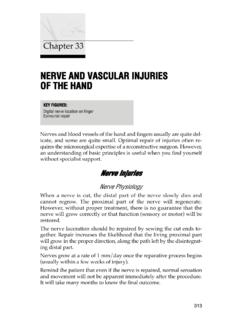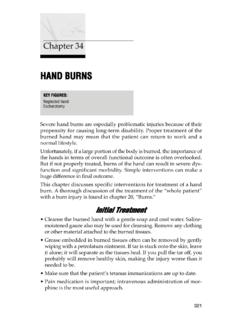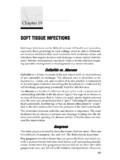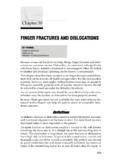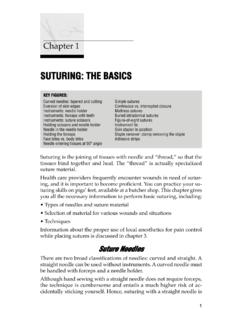Transcription of FRACTURES OF THE TIBIA AND FIBULA - Practical Plastic …
1 FFRRAACCTTUURREESS OOFF TTHHEETTIIBBIIAA AANNDD FFIIBBUULLAAF ractures of the TIBIA and FIBULA are a special concern because missingearly warning signs can result in a useless TIBIA and the FIBULA are the two long bones of the calf. FRACTURES ofthese bones often result from a sport-related injury or motor vehicle ac-cident. Most FRACTURES of the TIBIA and FIBULA (tib-fib FRACTURES ) healwithout complication, and the patient is able to resume his or hernormal activities. However, potentially serious complications can develop, and you mustbe aware of their early warning signs.
2 With this knowledge, you canintervene before permanent tissue damage develops. Early interven-tion may make the difference between a normally functioning patientwith a well-healed fracture and EExxaammpplleeAn 18-year-old boy was playing football and collided with anotherplayer, injuring his right leg. He tried to keep playing, but because thepain was so intense he could not place any weight on the leg. He satout the rest of the game and then came in for evaluation. The calf was swollen and tender, and the x-ray showed a minimallydisplaced mid-shaft tib-fib fracture.
3 No orthopedic surgeon was avail-able. After finding the fracture in Campbell s Orthopaedics, you placedhim in a cast, gave him crutches and pain medications, and sent 21 KKEEYY FFIIGGUURREESS::Calf anatomyLongstanding openHow to do fasciotomyfractureGastrocnemius andGastrocnemius flapneighboring structures206 Practical Plastic Surgery for NonsurgeonsHe returns a few days later in horrible pain. You remove the cast. Hiscalf is very tight and swollen, and except for the lateral aspect he hasno sensation in his foot. When you move his ankle, the pain intensifiesin his calf.
4 You check for pulses in his feet, and they are present. A general surgeon takes one look at the patient, and immediately sendshim to the operating room. Incisions are made in the calf, and much ofthe calf muscle is boy s leg will never function as it did before the injury. He willhave a life-long disability. What happened? First you need some basic background OOppeenn FFrraaccttuurreessFractures are usually classified as closed or open. Aclosed fracturemeans that the skin around the fracture site is terms of bone healing, closed FRACTURES have a favorable prognosisbecause of the low risk for infection of the bone (osteomyelitis) at thefracture site.
5 However, complications may arise, as illustrated by thecase an open fracture, also called a compound fracture, the skin aroundthe fracture site has been punctured. Open FRACTURES are more seriousinjuries because it generally takes greater forces to disrupt the skin andfracture the bones. An open fracture greatly increases the risk for thedevelopment of osteomyelitis, and osteomyelitis increases the risk forpoor quality of the soft tissue around the fractured bones plays a role infracture healing. Feel your own calf. The anterior surface of the TIBIA iscovered only by skin; there is not much padding around this injury to the skin around the TIBIA can result in exposure ofthe bone and thus a greater risk for poor healing of the fracture.
6 The higher the energy of the injury, the more significant the injury tothe soft tissue and the greater the potential for problems. Falling off astep results in a low-energy injury; being hit by a car results in a high-energy EElleemmeennttss ooff tthhee PPhhyyssiiccaall EExxaammiinnaattiioonn1. Is the skin intact? (open vs. closed fracture)2. If the skin is punctured, what can you see in the wound? Foreign ma-terial must be removed, and dead muscle or skin should be cut the fracture site is exposed, soft tissue coverage may be of the TIBIA and FIBULA 2073.
7 What is the vascular status of the leg? Check capillary refill. Checkthe pulses on the top of the foot (dorsalis pedis) and behind themedial malleolus (posterior tibial artery). If capillary refill or pulsesare not present, the patient may have a serious arterial injury. 4. What is the neurologic status of the leg? Evaluate the patient for ev-idence of nerve dysfunction or injury. Check sensation in the follow-ing areas: The first web space on the dorsum of the foot between the greattoe and the second toe: deep peroneal nerve The plantar surface of the foot: posterior tibial nerve The lateral aspect of the foot: sural nerveCheck active ankle motion and toe motion: Plantarflexion of the ankle and toes (pointing of toes and foot):posterior tibial nerve Dorsiflexion of the ankle and toes (bringing the toes and footupward toward the front of the calf).
8 Anterior tibial nerve Eversion (elevating the lateral side of the foot): peroneal nerve5. What are the radiographic findings? A single break in each of thebones usually heals with fewer complications than when the bonesare broken into many pieces (a comminuted fracture). A largenumber of fragments indicates a higher-energy injury, which is as-sociated with a higher rate of Evaluate the patient for signs and symptoms of compartment syn-drome. If they are present, you have a surgical emergency on yourhands (see below).
9 CCoommppaarrttmmeenntt SSyynnddrroommeeA compartment syndrome develops when pressure builds up within afixed, well-defined space. The increase in pressure prevents venousand lymphatic outflow, and fluid build-up leads to a further increasein pressure in the tissues. High pressures can cause tissue injury pressures also prevent blood and nutrients from reaching the tis-sues, causing further injury. Without appropriate intervention to re-lieve pressure build-up, a vicious cycle develops. This is essentially thedefinition of a compartment and nerve are the tissues most prone to injury.
10 If a compartmentsyndrome remains untreated even for a few hours, the result is muscledeath, which translates into tissue loss and permanent death of muscle tissue can also be a very serious problem for thepatient s overall health. A muscle breakdown byproduct, myoglobin,208 Practical Plastic Surgery for Nonsurgeonsis released into the bloodstream and can cause permanent kidneydamage. Thus a compartment syndrome not only endangers normalfunction; it can also threaten the patient s life. For these reasons, thetreatment of a compartment syndrome is a surgical emergency.
